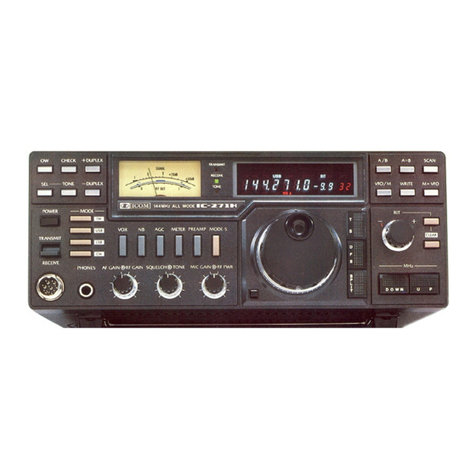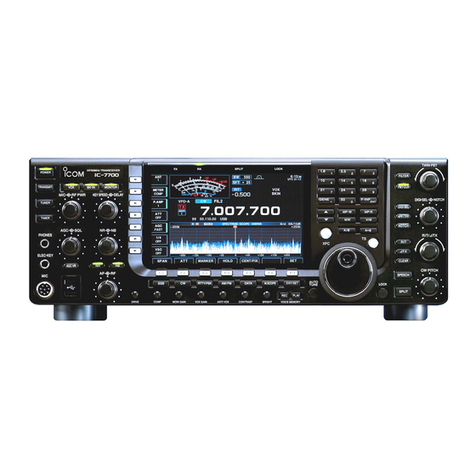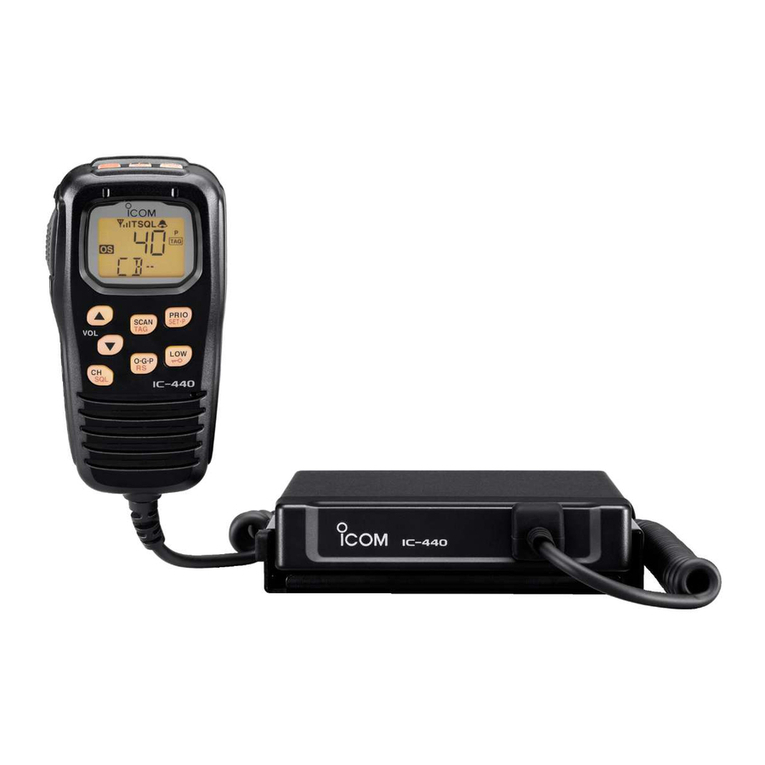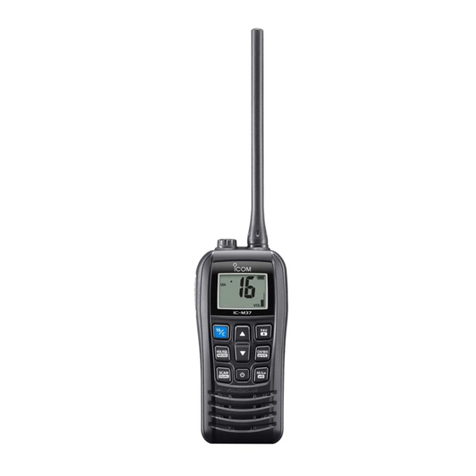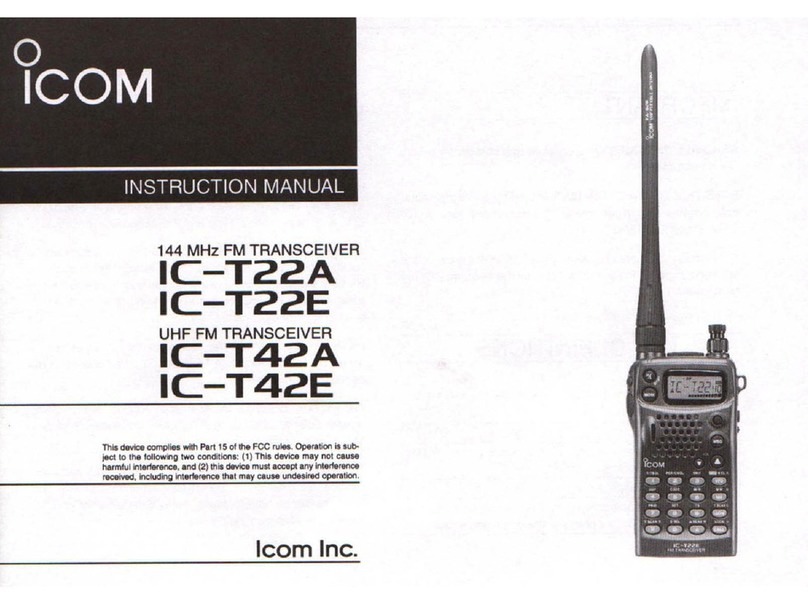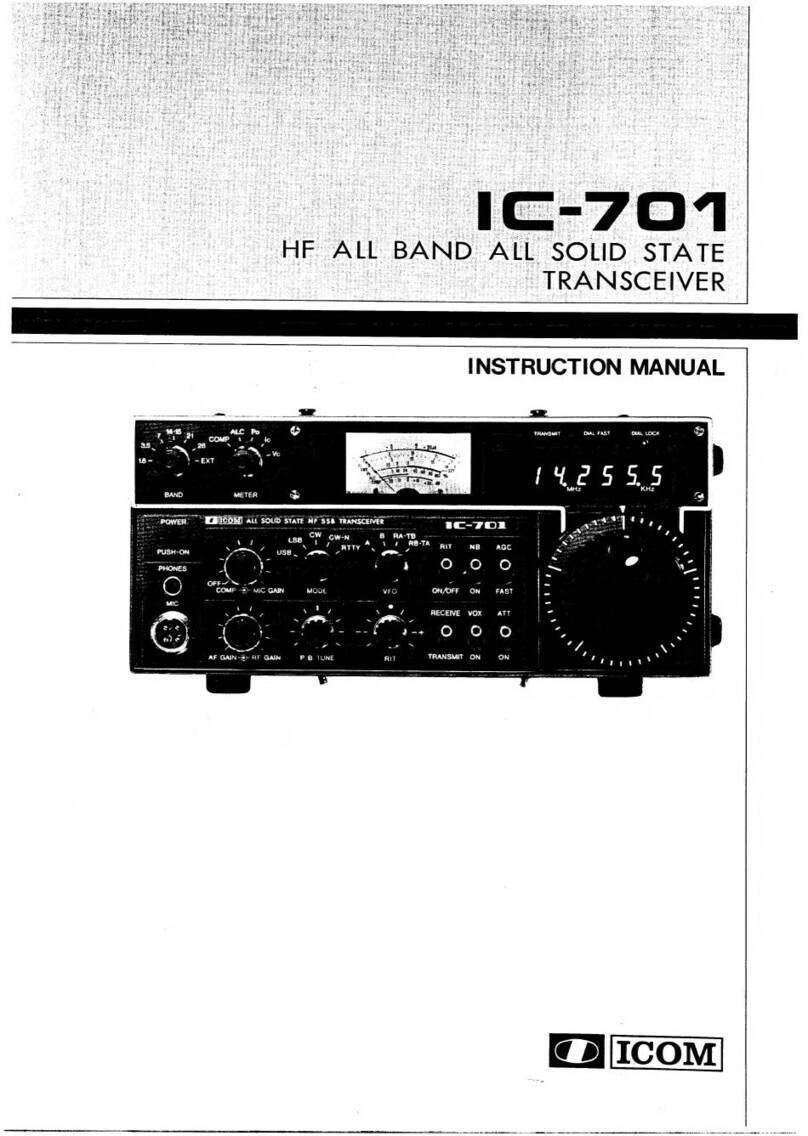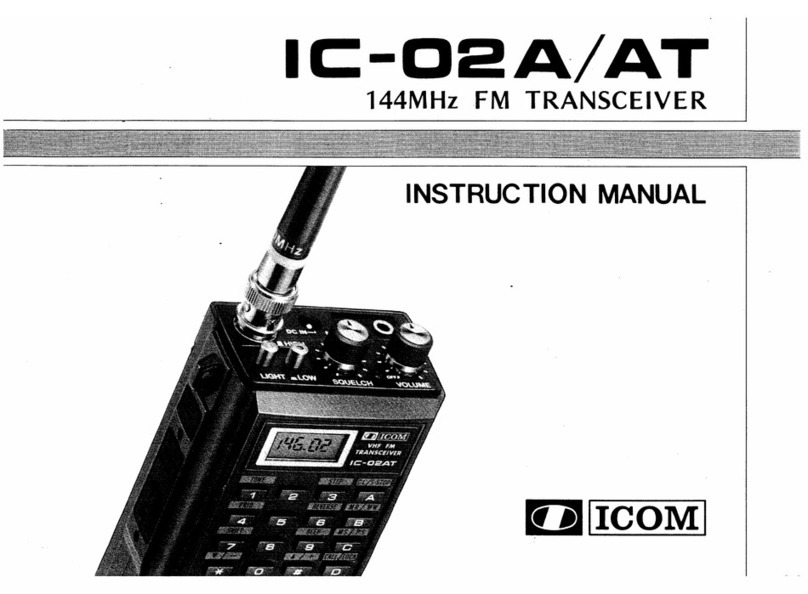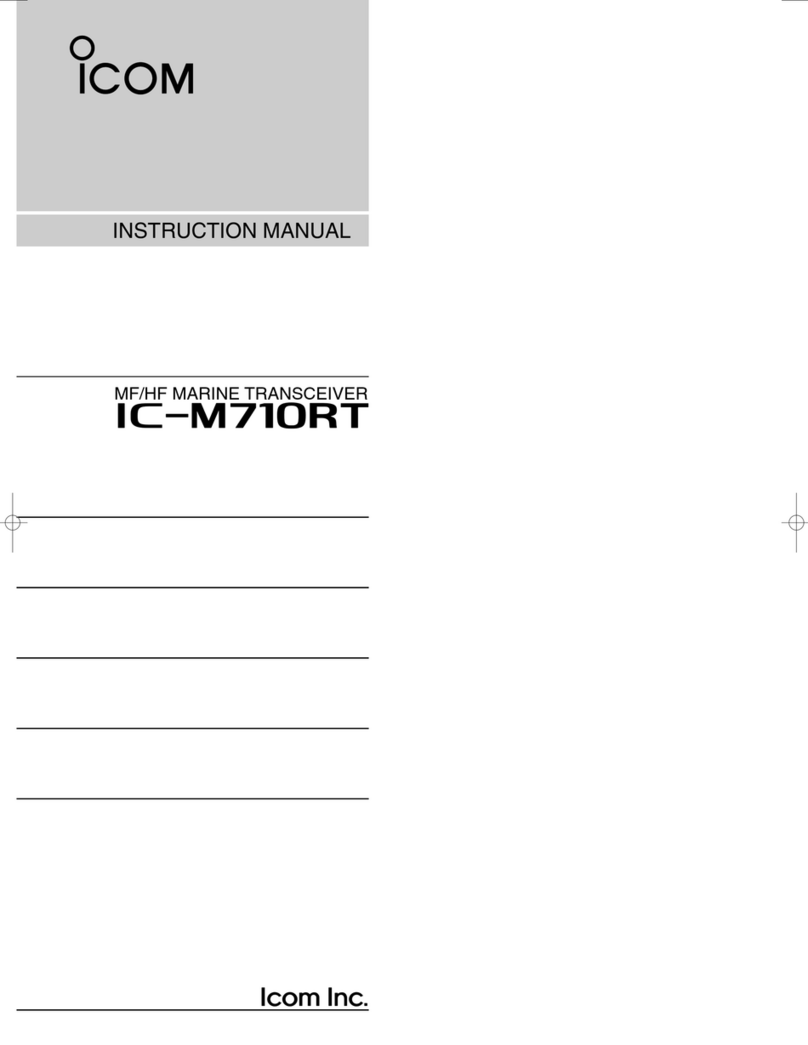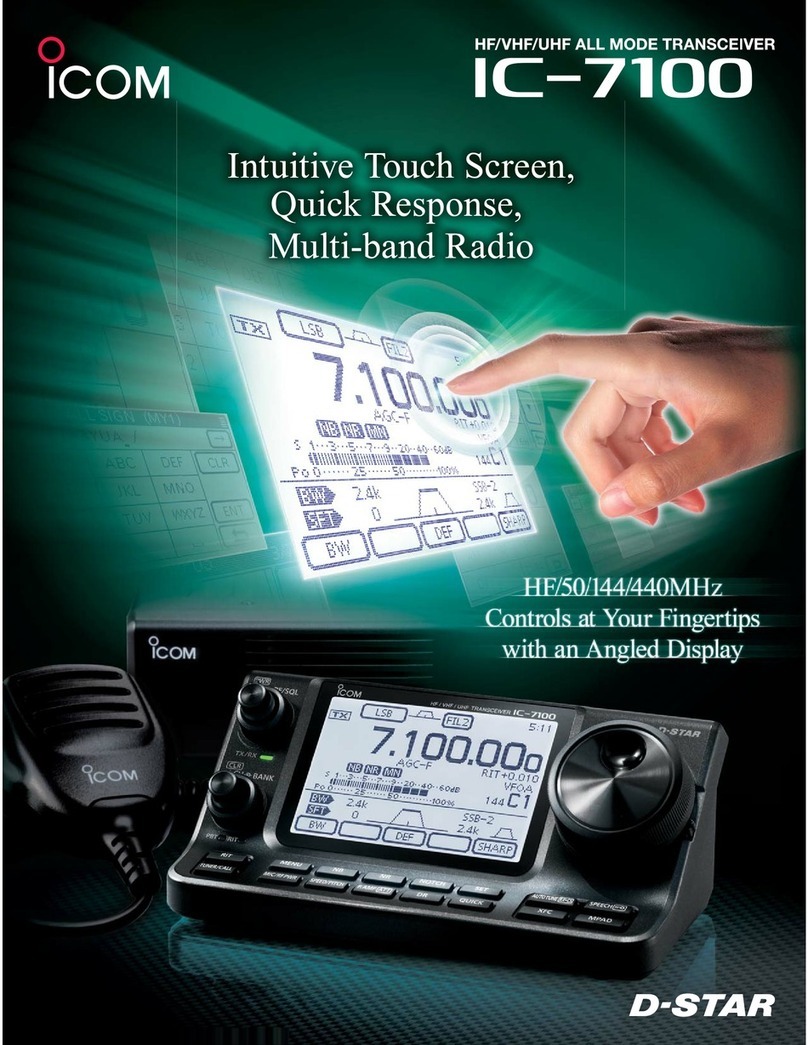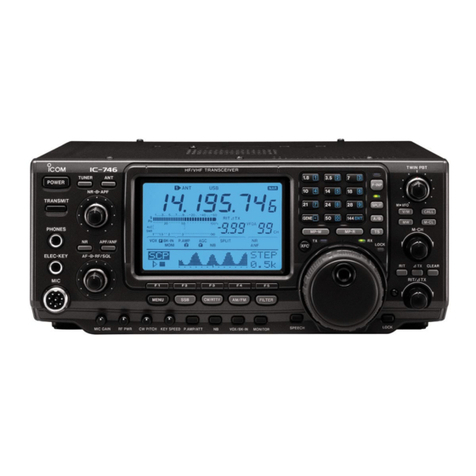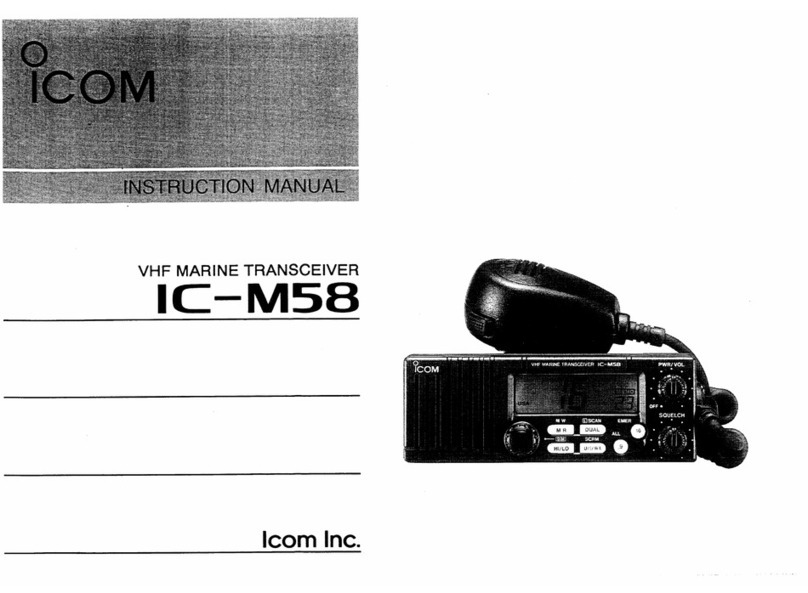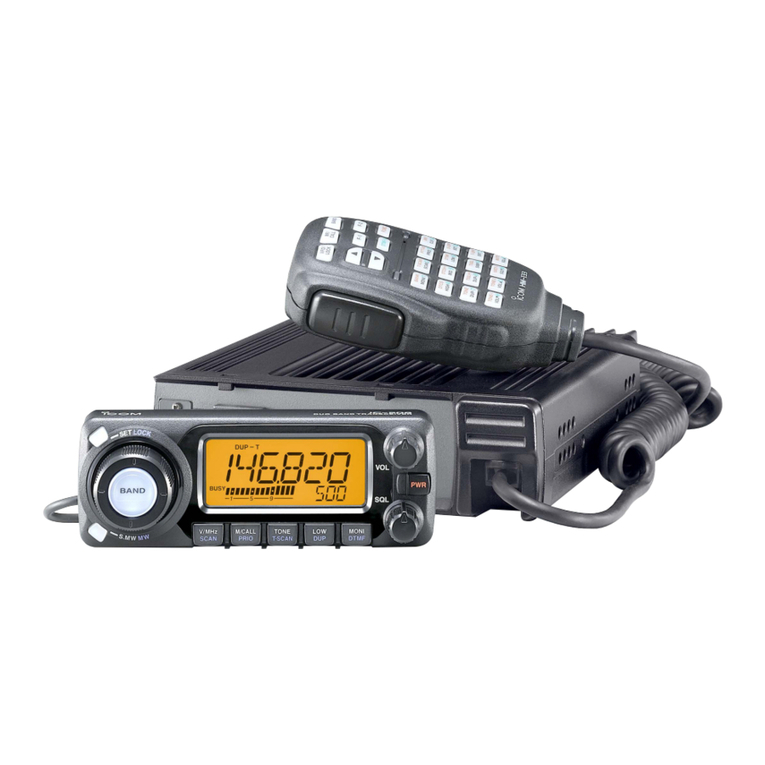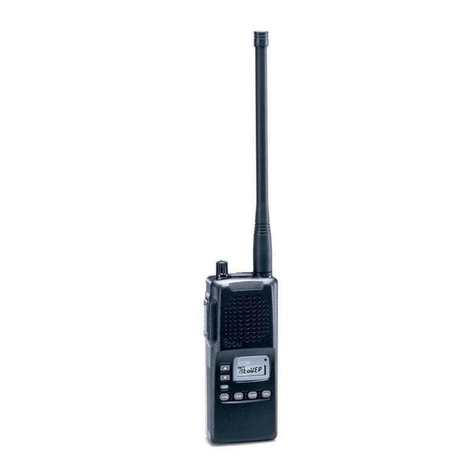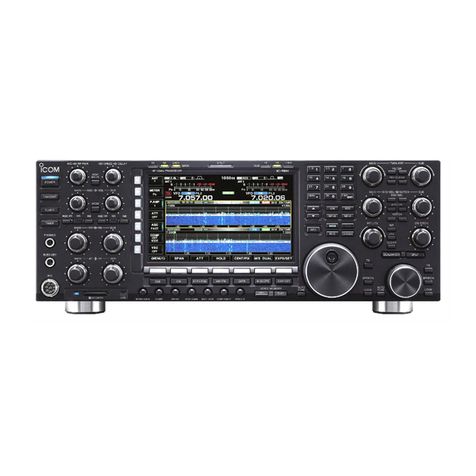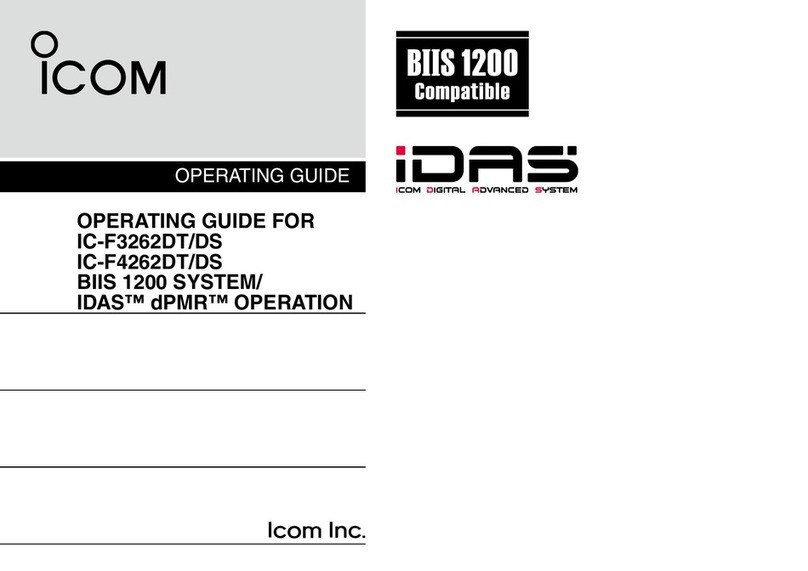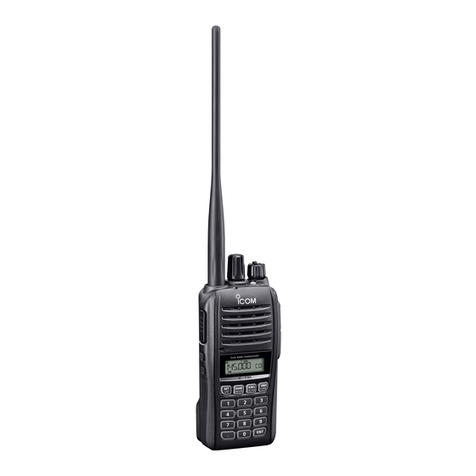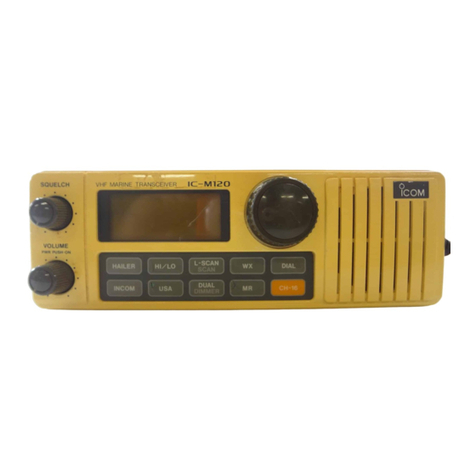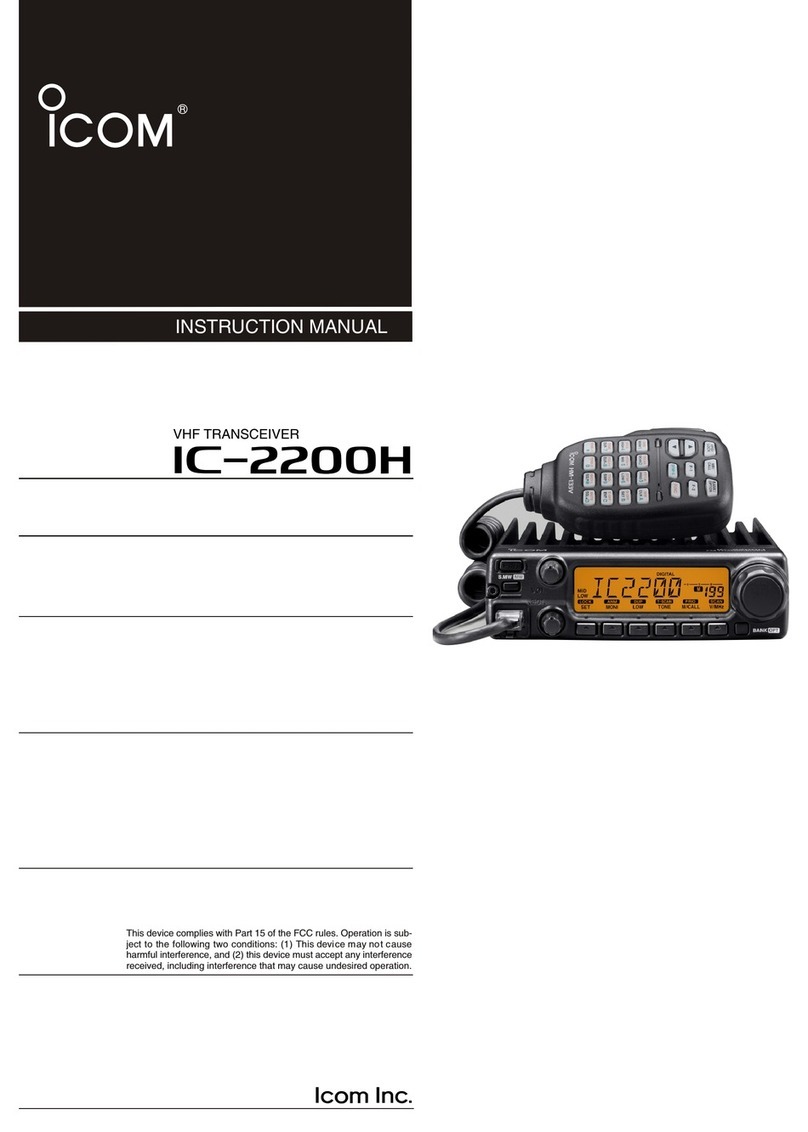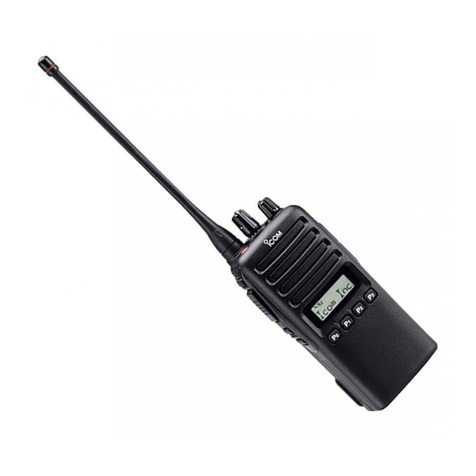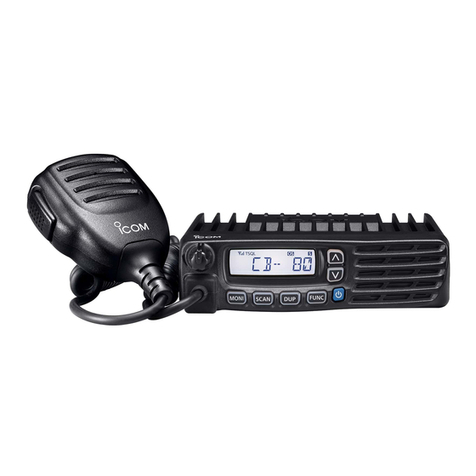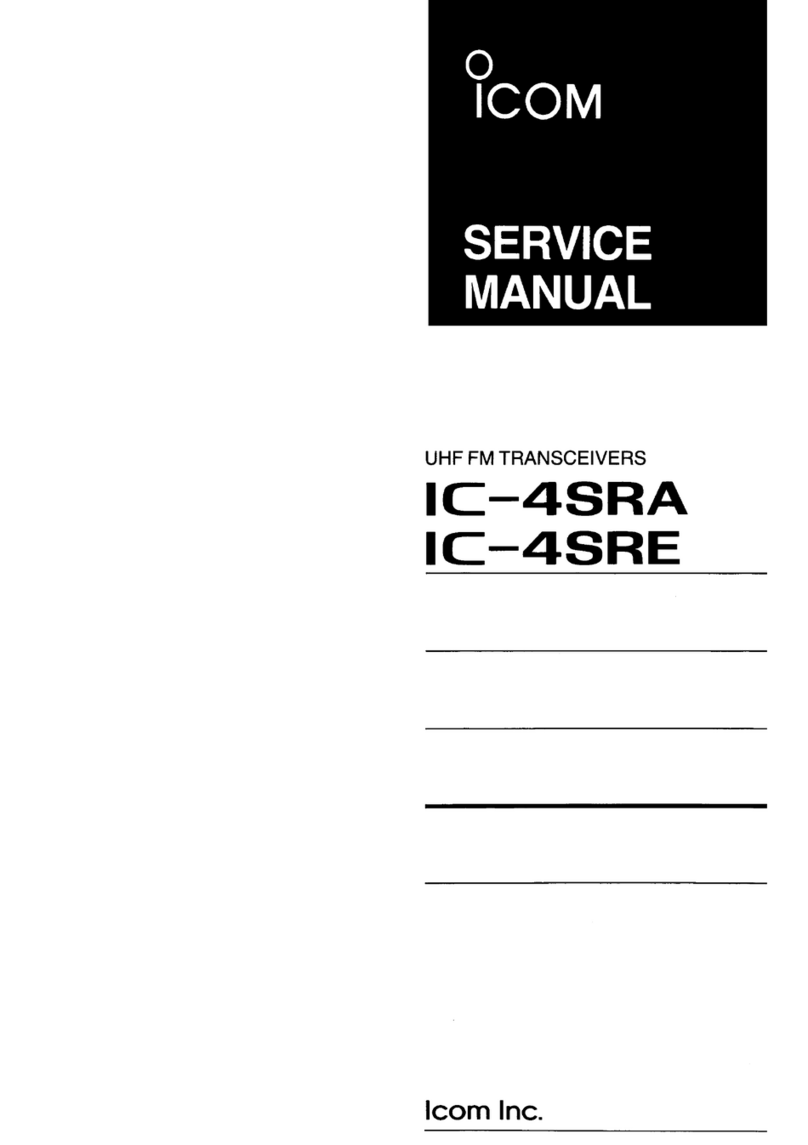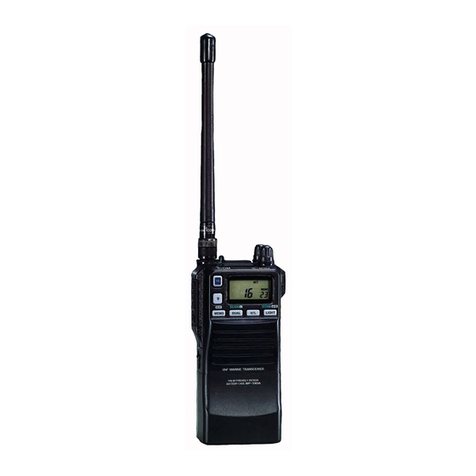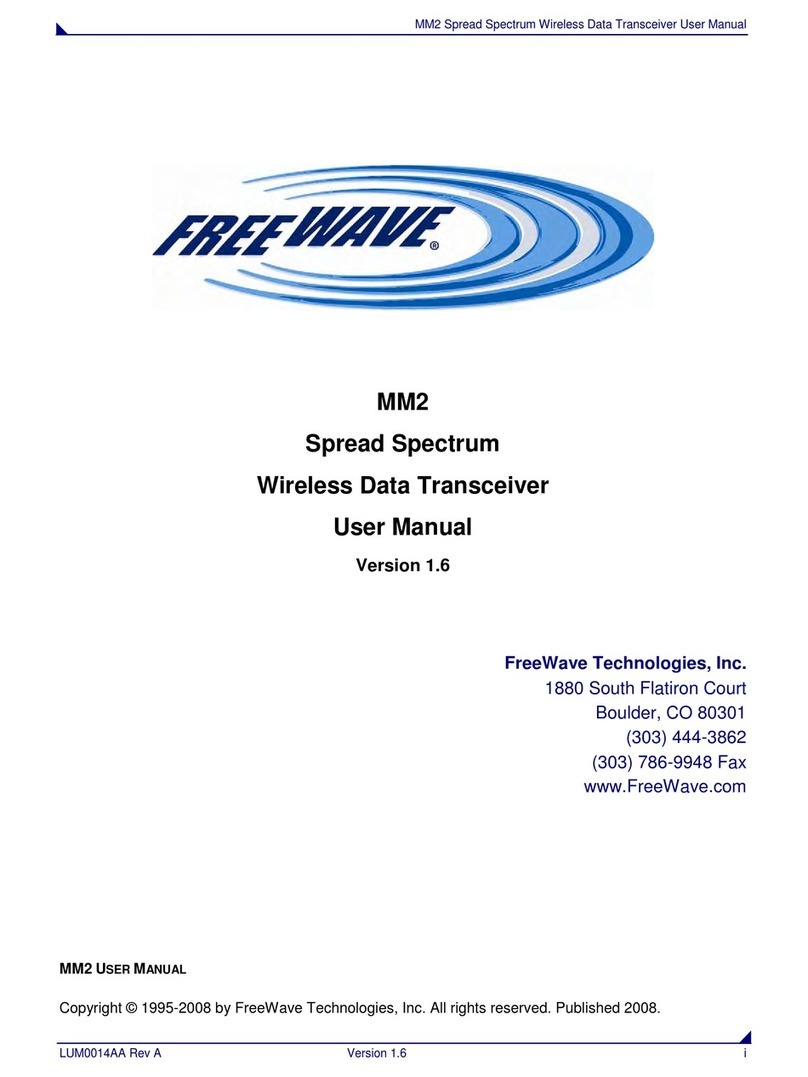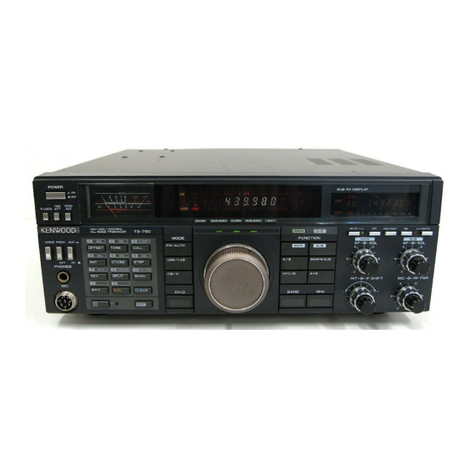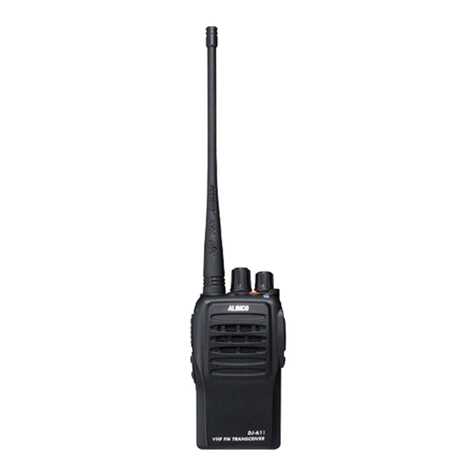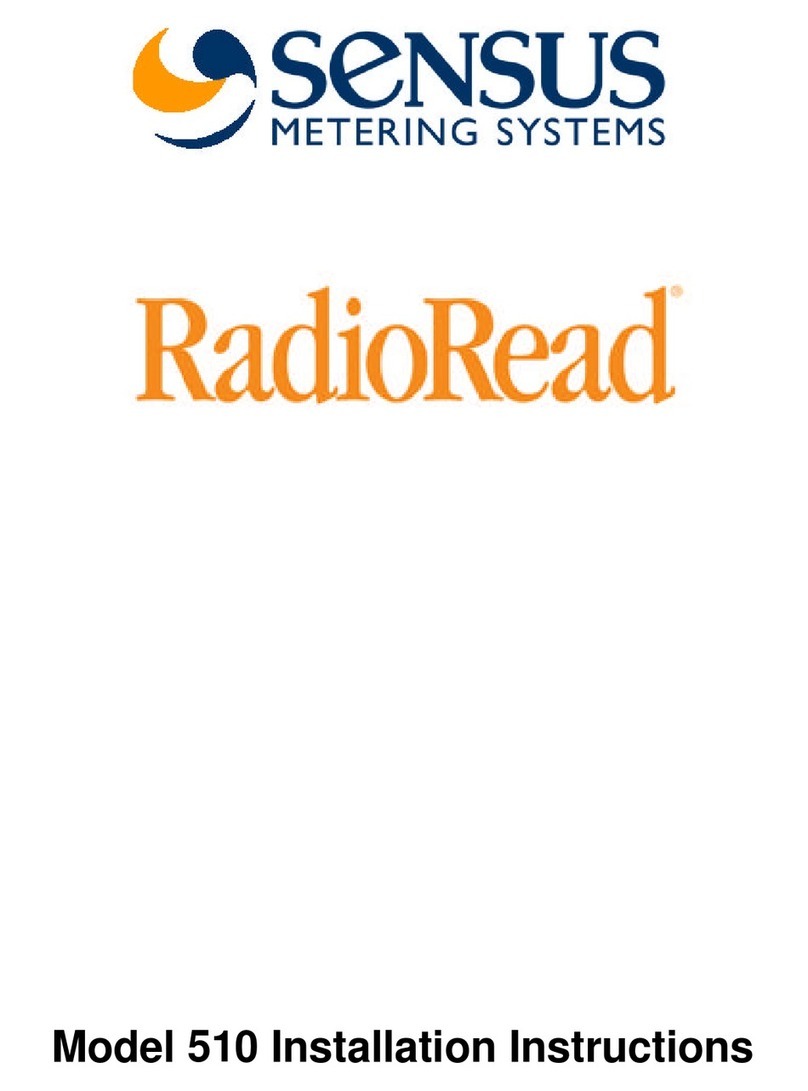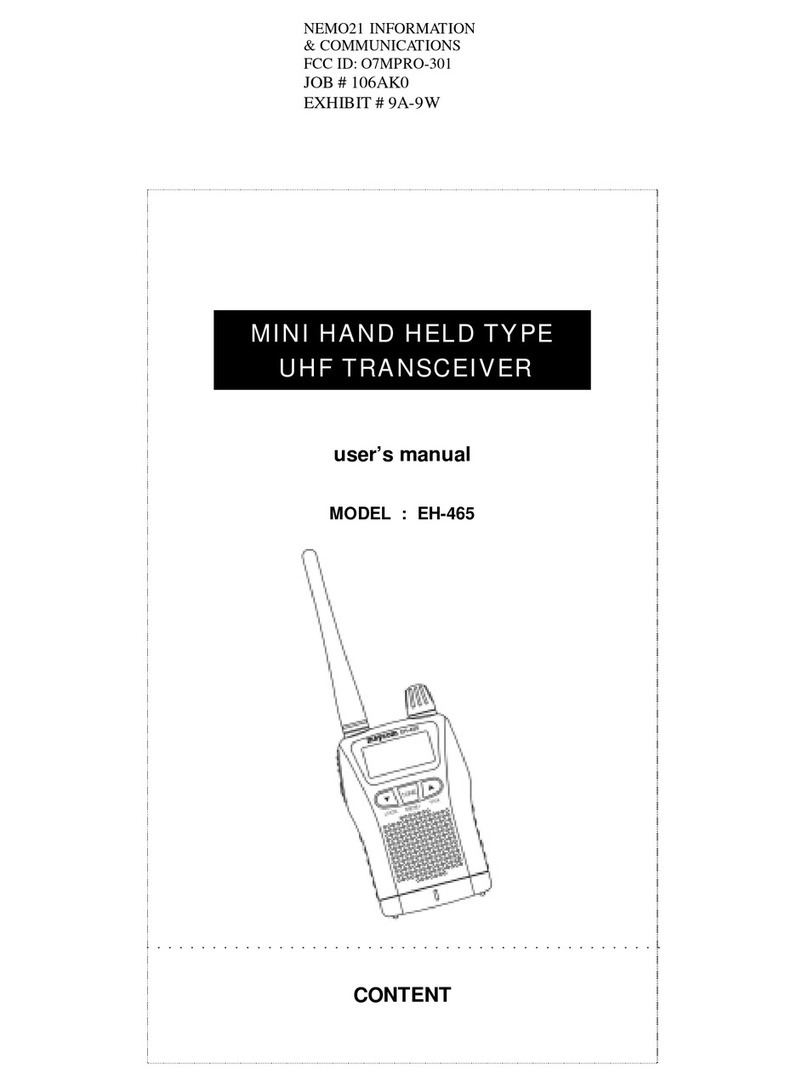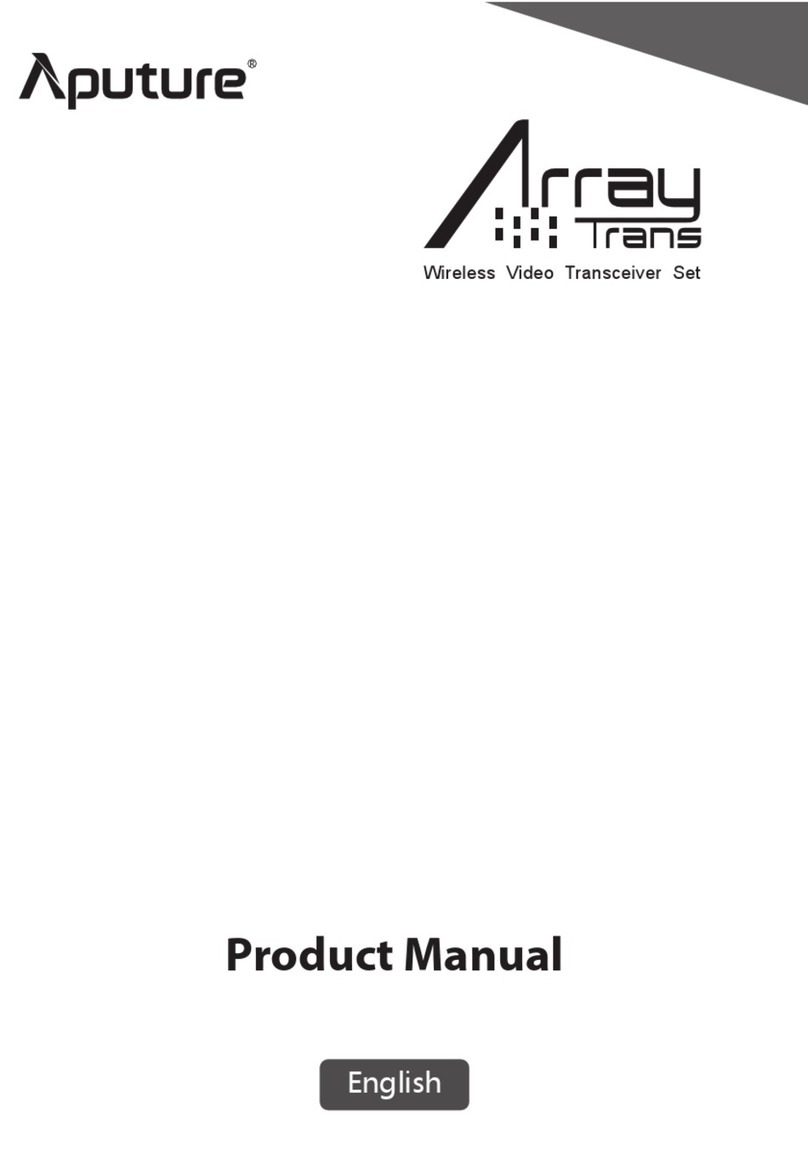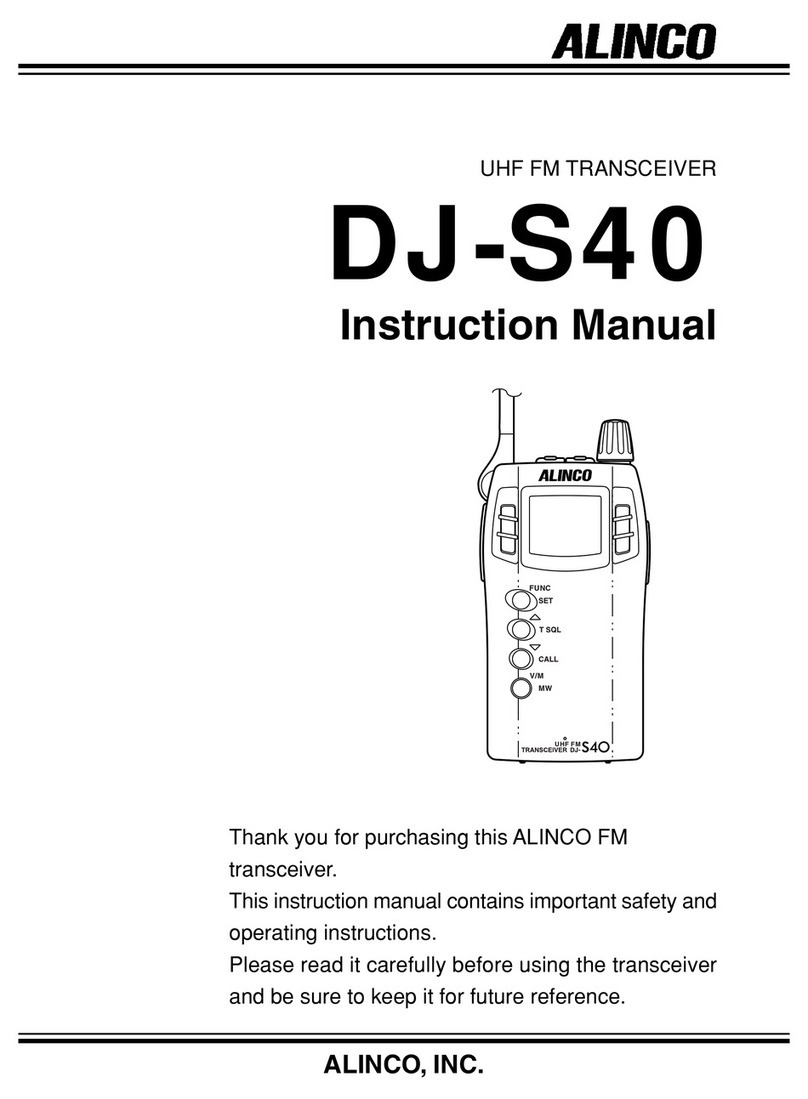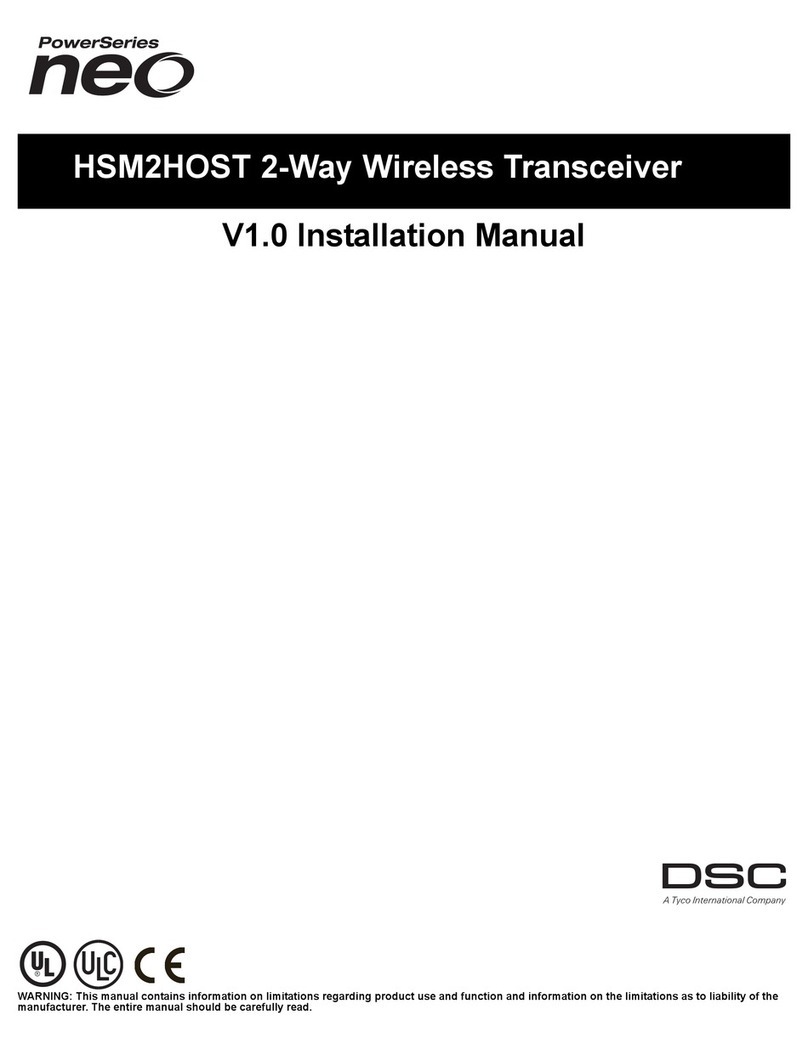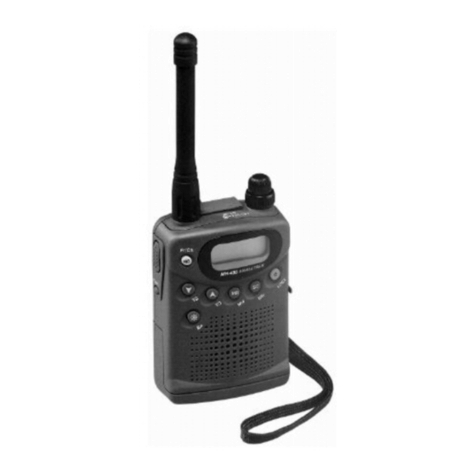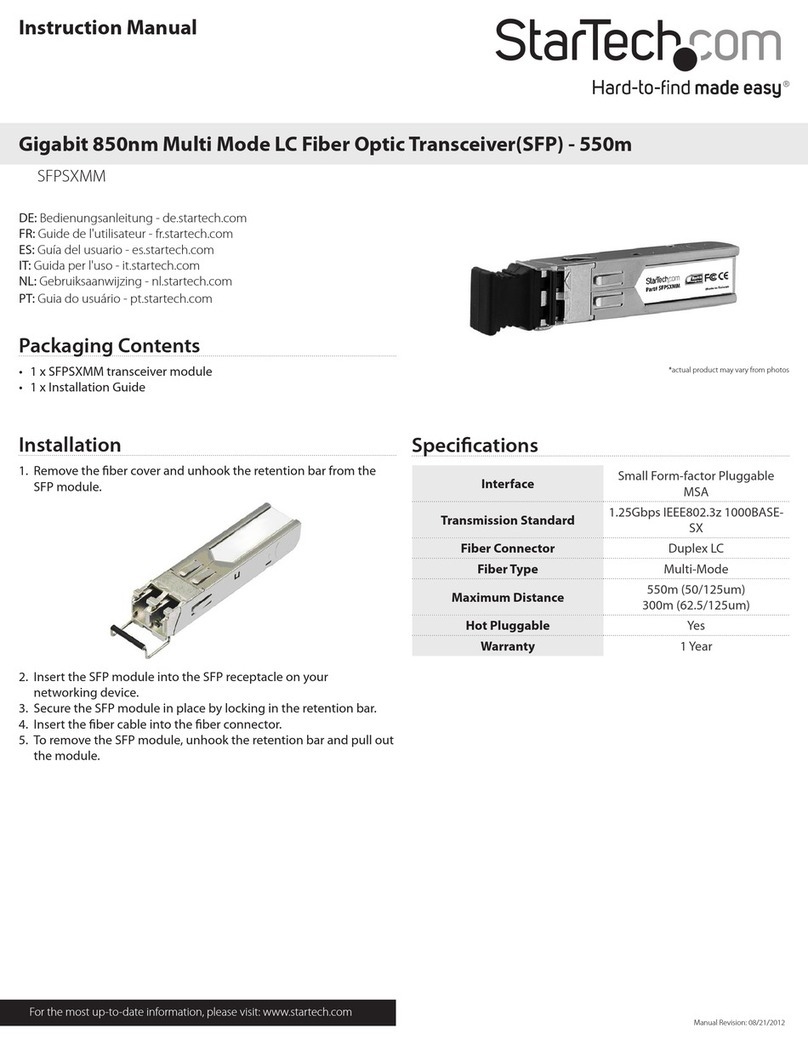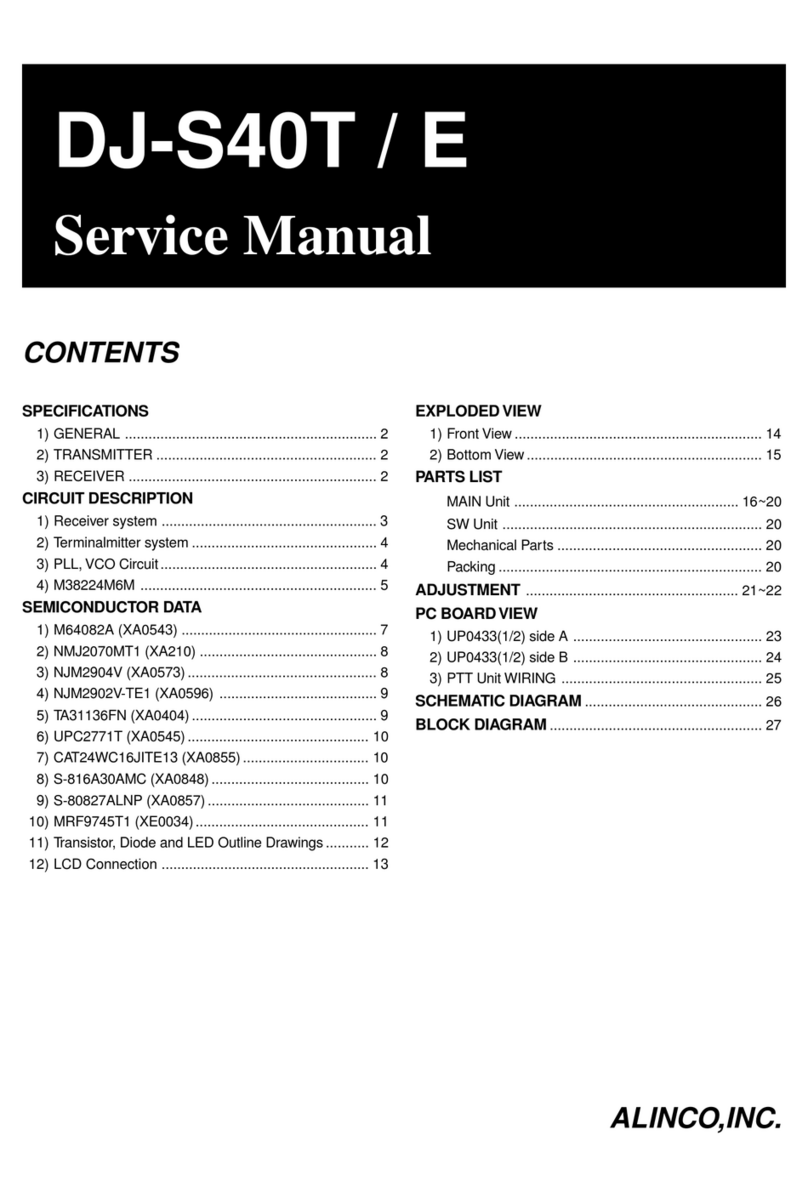Icom ID-51A Installation guide

This device complies with Part 15 of the FCC Rules. Operation is
subject to the following two conditions: (1) this device may not cause
harmful interference, and (2) this device must accept any interference
received, including interference that may cause undesired operation.
WARNING: MODIFICATION OF THIS DEVICE TO RECEIVE CEL-
LULAR RADIOTELEPHONE SERVICE SIGNALS IS PROHIBITED
UNDER FCC RULES AND FEDERAL LAW.
BASIC INSTRUCTIONS
New2001
ID-51A
VHF/UHF TRANSCEIVER
ID-51E
VHF/UHF TRANSCEIVER
L
e
t
’
s
b
e
g
i
n
u
s
i
n
g
D
-
S
T
A
R
!
You can easily begin using
D-STAR repeaters!

1
New2001New2001
UNIQUE FEATURES OF D-STAR
Easy to QSO to the world●
Easy call sign entry with●
the Repeater list or TX/RX
History
Call Sign Capture key●
makes call sign capture
easy.
Easy Desti-
nation (To)
setting!
Worldwide
communication!!
This key makes call sign
capture easy!

PREPARATION
New2001
PREPARATION
IMPORTANT!
Before starting D-STAR, entering and registering your call sign (MY) are needed, as described below.
STEP 1 Entering your call sign (MY) into the transceiver. STEP 2 Registering your call sign (MY) to a
gateway repeater. You have completed the steps!!
STEP 1
Enter your call sign into the transceiver
Example: Enter “JA3YUA” as your own call sign into the MY
call sign memory [MY1].
Hold downq
[ ]
for 1 second to
turn ON the power.
•Holddown[ ] for 1 second to
turn OFF power.
•Aftertheopeningmessageand
power source voltage are dis-
played, the operating frequency
appears.
Push [MENU]w.
•TheMENU screen is displayed.
Push D-pad(e) to select the
root item (“My Station”), and
then push D-pad(Ent).
D-pad
(�)
(Ent)
Push D-pad(r) to select “My
Call Sign,” and then push D-
pad(Ent).
•The MY CALL SIGN screen is
displayed.
MENU screen
Go to step t
Continued on the next page
This is page 2.
[ ]

New2001
3
PREPARATION
New2001
Push D-pad(t) to select MY
call sign memory channel “1”
([MY1]).
D-pad
(�)
(Ent)
Push [QUICK]y, and then
push D-pad() to select
“Edit.” Then, push D-pad(Ent)
to enter the call sign edit
mode.
•Acursorappearsandblinks.
Rotate [DIAL] to select theu
first digit. (Example: J)
•AtoZ,0to9,/and(Space)are
selectable.
•Cursormove:PushD-pad().
•Delete:Push[CLR]
.
•Insert:
Move cursor, then rotate
[DIAL].
•Rotate[DIAL]counterclockwise
to enter a space.
PushiD-pad() to move the
cursor to the second digit.
NOTE: Your call sign must
match the call sign registered
to your gateway repeater. (p. 4)
Repeat stepso u and ito
enter your own call sign of
up to 8 characters, including
spaces.
(For example: First J, then A,
then 3, then Y, then U, then A)
!0 Push D-pad(Ent) to set the
call sign.
•Seenextpageifyouentera
note.
!1 Push D-pad(Ent) again to
save and return to the MY
CALL SIGN screen.
•Twobeepssound.
!2 Push [MENU] to exit the
MENU screen.
Edit mode
Beeps
Completed
Go to step o
[DIAL]
Selects/exitsthe
MENU screen
Moves the
cursor
Selects
Deletes
Shows the
QUICK MENU
Keys used for input

New2001
4
PREPARATION
Access the repeater p. 17
How to use the RX History p. 21
Capturing a call sign p. 25
MakingaLocalareacall p.27
MakingaGatewaycall p.29
Calling a destination station p. 31
MakingaSimplexcall p.33
If needed, ask the gateway repeater administrator for
call sign registration instructions.
To use a repeater gateway, you must register your call sign
with a gateway repeater, usually one near your home location.
RX
TX
Now, you can begin using D-STAR!
New users
start here!
In the next step, register your
call sign to a gateway repeater.
I can begin using
D-STAR!!
Completed!!
Convenient!✓
If necessary, enter a note of up to 4 characters, such as the
model of the transceiver, name, area name, and so on, after
your call sign.
PushqD-pad() until the cursor
moves to the right of the “/”.
Repeat stepsw u and ito the left to
enter a desired 4 character note.
(Example: ID51)
STEP 2
Register your call sign to a gateway repeater
Troubleshooting p. 35

5
New2001New2001
TABLE OF CONTENTS
New2001
D-STAR Operation D-STAR Operation
Answer the questions,
and figure out your
operating steps!
Start
Confirm you can
access your local
repeater?
YES Go to page 17
NO
Reply to a call?
YES
NO
How to easily reply using the call-
ing station’s call sign?
Call Sign Capture key Go to page 25
RX History Go to page 21
Making a call in your local area?
(Local area call)
YES Go to page 27
NO
Use a repeater?
YES
NO Go to page 33
Making a call to another area?
(Gateway call)
To a specific station
To anyone Go to page 29
NOTE: This chart may not apply to your specific environment.

New2001
6
TABLE OF CONTENTS
New2001
Other functions
D-STAR Operation D-STAR Operation
Saving settings
Go to page 37
Learn about
the new built
in functions
Go to page 47
Troubleshooting
Go to page 35
Checking your
position using
GPS
Go to page 43
Recording a QSO
conversation
Go to page 39
Checking your
route using the
GPS logger
function
Go to page 45
The destination call sign is al-
ready programmed?
YES Go to page 31
NO Go to section 9 of the CD Ad-
vanced Instruction PDF for call
sign programming.Then, Go to
page 31 of this manual.
•If you have received a call
from the station before, the
call sign may be in RX History.
(p. 21)

7
TABLE OF CONTENTS
New2001
UNIQUE FEATURES OF D-STAR ..................... 1
PREPARATION ............................................ 2–16
Enter your call sign into the transceiver................................2
Register your call sign to a gateway repeater.......................4
TABLE OF CONTENTS........................................................5
FOREWORD ........................................................................9
FEATURES...........................................................................9
EXPLICIT DEFINITIONS....................................................10
IMPORTANT.......................................................................10
SUPPLIED ACCESSORIES...............................................10
ABOUT THE SUPPLIED CD ..............................................11
Starting the CDD......................................................11
PRECAUTIONS..................................................................12
BATTERY CAUTIONS ........................................................14
Battery cautionD.......................................................14
Charging cautionD....................................................15
Charging timeD.........................................................15
IMPORTANT NOTES..........................................................16
When using the GPS receiverD................................16
Spurious signalsD.....................................................16
About charging at power OND..................................16
1 ACCESS THE REPEATER.................... 17–20
STEP1 Select the DR mode .........................................17
STEP2 Select your Access repeater (“FROM”) ............17
STEP3 Select the Destination repeater (“TO”) .............19
STEP4 Checkwhetheryoucanaccesstherepeater ...20
2 HOW TO USE THE RX HISTORY.......... 21–24
STEP1 View the received call sign ...............................21
STEP2 Save the destination call sign into
your call sign memory from the RX History......22
3 CAPTURING A CALL SIGN.................. 25–26
STEP1 Set the received call sign to the destination .....26
STEP2 Hold down [PTT] to transmit.............................26
4 MAKING A LOCAL AREA CALL.......... 27–28
STEP1 Set “FROM” (Access repeater).........................27
STEP2 Set “TO” (Destination).......................................28
STEP3 Hold down [PTT] to transmit.............................28
5 MAKING A GATEWAY CALL................ 29–30
STEP1 Set “FROM” (Access repeater).........................29
STEP2 Set “TO” (Destination).......................................30
STEP3 Hold down [PTT] to transmit.............................30

8
TABLE OF CONTENTS
6 CALLING A DESTINATION STATION .. 31–32
STEP1 Set “FROM” (Access repeater).........................31
STEP2 Set “TO” (Destination).......................................32
STEP3 Hold down [PTT] to transmit.............................32
7 MAKING A SIMPLEX CALL ................. 33–34
STEP1 Set “FROM” (Simplex channel).........................33
STEP2 Hold down [PTT] to transmit.............................34
8 TROUBLESHOOTING........................... 35–36
9 SAVING SETTINGS .............................. 37–38
STEP1 Saving settings into memory ............................37
STEP2 View the saved contents...................................38
10 RECORDING A QSO ONTO A
MICROSD CARD................................... 39–42
About using a microSD card■.....................................39
STEP1 Inserting the microSD card...............................39
STEP2 Format the microSD card .................................40
STEP3 Recording a QSO audio ...................................41
STEP4 Playingbacktherecordedaudio ......................42
11 GPS OPERATION ................................. 43–44
STEP1 Receiving GPS data from the internal
GPS receiver ....................................................43
STEP2 Displaying your position....................................44
12 GPS LOGGER FUNCTION ................... 45–46
STEP1 Receiving GPS data from the internal
GPS receiver ....................................................45
STEP2 Turning ON the GPS Logger function...............46
13 INTRODUCING NEW FUNCTIONS ...... 47–48
Voice Recorder function................................................47
Two bands monitoring plus BC Radio ...........................47
Auto Position Reply function .........................................48
Voice TX function ..........................................................48
Speech function ............................................................48
TemporarySkipfunction ...............................................48
14 RESETTING .......................................... 49–50
Resetting■...................................................................49
15 INFORMATION............................................ 51
COUNTRY CODE LIST ................................................51
FCC INFORMATION.....................................................51
INDEX......................................................... 52–54

9
New2001 New2001
FOREWORD
ThankyouforpurchasingthisneIcomproduct.TheID-51A
or ID-51E v h f /u h f t r a n s c e i v e r is designed and build with
Icom’s superior technology and craftsmanship combining tra-
ditional analog technologies with the new digital technology,
Digital Smart Technologies for Amateur Radio (D-STAR), for
abalancedpackage.
With proper care, this product should provide you with years
of trouble-free operation.
WethankyouformakingyourID-51AorID-51Eyourradioof
choice, and hope you agree with Icom’s philosophy of “tech-
nology first.” Many hours or research and development went
into the design of your ID-51A or ID-51E.
FEATURES
Dual independent receivers in one radio;❍
receives two bands simultaneously
Two band monitoring plus the Broadcast
(BC) Radio
•Dependingontheselectedoperatingmode,Dual-
watch or Triple-watch cannot be made.
Rapid charging is possible, and the charg-❍
ing time period is approximately 3 hours
with the supplied battery pack. (Half peri-
ods of the ID-31A/E)
Built-in GPS receiver allows you to check❍
your current position, or automatically send
a reply with your position to the called
ID-51A/E
Voice recorder records your QSO conver-❍
sation, voice audio for TX and microphone
voice audio
microSD card slot that can accept different❍
cards to backup settings, various memo-
ries, the GPS log and so on
Icom,IcomInc.andtheIcomlogoareregisteredtrademarksofIcom
Incorporated (Japan) in Japan, the United States, the United King-
dom, Germany, France, Spain, Russia and/or other countries.
AdobeandAdobeReaderareeitherregisteredtrademarksortrade-
marksofAdobeSystemsIncorporated,intheUnitedStatesand/or
other countries.
Microsoft,WindowsandWindowsVistaareregisteredtrademarksof
Microsoft Corporation in the United States and/or other countries.

New2001
10
EXPLICIT DEFINITIONS
WORD DEFINITION
RDANGER! Personal death, serious injury or an ex-
plosion may occur.
RWARNING! Personal injury, fire hazard or electric
shockmayoccur.
CAUTION Equipment damage may occur.
NOTE Recommendedforoptimumuse.Norisk
ofpersonalinjury,reorelectricshock.
IMPORTANT
READ ALL INSTRUCTIONS carefully and completely
before using the transceiver.
SAVE THIS INSTRUCTION MANUAL— This in-
struction manual contains basic operating instructions for the
ID-51A/ID-51E.
SUPPLIED ACCESSORIES
The following accessories are supplied with the transceiver.
qAntenna .......................................................................... 1
wHand strap ..................................................................... 1
eBattery charger (BC-167SA/SD/SV)* ............................. 1
rBelt clip .......................................................................... 1
tBatterypack(BP-271).................................................... 1
yCD (Including the CS-51 c l o n i n g s o f t w a r e )................. 1
* Not supplied, or the shape is different, depending on the
transceiver version.
qew
ryt

11
New2001 New2001
The following instructions and installers are included on the
CD.
•Basicinstructions
Instructions for the basic operations, the same as this man-
ual
•AdvancedInstructions
Instructions for the advanced operations and more details
are described than in this manual
•HAMradioTerms
A glossary of HAM radio terms
•CS-51Instructionmanual
Instructions for the CS-51 cloning software installation and
use
•CS-51Installer
Installer for the CS-51 cloning software
•Adobe®Reader®Installer
Installer for Adobe®Reader®
DStarting the CD
ABOUT THE SUPPLIED CD
Insert the CD into the CD drive.q
•Doubleclick“Autorun.exe”ontheCD.
•DependingonthePCsetting,theMenuscreenshown
below is automatically displayed.
Clickthedesiredbuttontoopenthele.w
•ToclosetheMenuscreen,click[Quit].
A PC with the following Operating System is required.
•Microsoft®Windows® 8, Microsoft®Windows® 7, Microsoft®
Windows Vista®or Microsoft®Windows® XP
To read the guide or instructions, Adobe®Reader®is required.
If you have not installed it, please install the Adobe®Reader®
on the CD or downloaded it from Adobe Systems Incorporat-
ed’s web
site.
Quits the menu screenInstalls the Adobe®Reader®
Opens the
Glossary
Opens the
Basic
Instructions
(this manual)
Installs the
CS-51
Opens the
Advanced
Instructions
Opens the
CS-51
Instructions

New2001
12
1
2
3
4
5
6
7
8
9
10
11
12
13
14
15
16
17
18
19
RDANGER! NEVER short the terminals of the bat-
terypack.
RDANGER! Use and charge only specified Icom battery
packswithIcomradiosorIcomchargers.OnlyIcombattery
packsaretested andapprovedforuse withIcomradios or
charged with Icom chargers. Using third-party or counterfeit
batterypacksorchargers maycausesmoke,re,orcause
the battery to burst.
RWARNING RF EXPOSURE! This device emits
Radio Frequency (RF) energy. Caution should be observed
when operating this device. If you have any questions regard-
ing RF exposure and safety standards, please refer to the
Federal Communications Commission Office of Engineering
and Technology’s report on Evaluating Compliance with FCC
Guidelines for Human Radio Frequency Electromagnetic
Fields (OET Bulletin 65).
RWARNING! NEVER hold the transceiver so that
the antenna is very close to, or touching exposed parts of
the body, especially the face or eyes, while transmitting. The
transceiver will perform best if the microphone is 5 to 10 cm
(2 to 4 inches) away from the lips and the transceiver is verti-
cal.
RWARNING! NEVER operate or touch the trans-
ceiverwithwethands.Thismayresultinanelectricshockor
may damage the transceiver.
RWARNING! NEVER operate the transceiver with
an earphone, headphones or other audio accessories at high
volume levels. Hearing experts advise against continuous
high volume operation. If you experience a ringing in your
ears, reduce the volume level or discontinue use.
RWARNING! NEVER operate the transceiver while
driving a vehicle. Safe driving requires your full attention—
anything less may result in an accident.
RWARNING! NEVER connect the transceiver to a
power source of more than 16 V DC or use reverse polarity.
This could cause a fire or damage the transceiver.
CAUTION: MAKE SURE the flexible antenna and
battery pack are securely attached to the transceiver, and
thattheantennaandbatterypackaredrybeforeattachment.
Exposing the inside of the transceiver to water will result in
serious damage to the transceiver.
After exposure to water, clean the battery contacts thoroughly
with fresh water and dry them completely to remove any wa-
ter or salt residue.
PRECAUTIONS

13
New2001 New2001
CAUTION: DO NOT use harsh solvents such as ben-
zine or alcohol to clean the transceiver, because they can
damage the transceiver’s surfaces.
DO NOT push the PTT unless you actually intend to trans-
mit.
DO NOT operate the transceiver near unshielded electri-
cal blasting caps or in an explosive atmosphere.
DO NOT use or place the transceiver in direct sunlight
or in areas with temperatures below –20°C (–4˚F) or above
+60°C (+140˚F).
BE CAREFUL! The transceiver will become hot when
operating it continuously for long periods of time.
BE CAREFUL! The transceiver meets IPX7* require-
ments for waterproof protection. However, once the trans-
ceiver has been dropped, waterproof protection cannot be
guaranteed because of possible damage to the transceiver's
case or waterproof seal.
* Only when the BP-271 or BP-272 (option), flexible antenna,
[MIC/SP] cap, [DATA/DC IN] cap and [micro SD] slot cap
are attached.
Place the unit in a secure place to avoid inadvertent use by
children.
The BP-273 meets IPX4 requirements for splash resistance.
When it is connected, the transceiver corresponds to IPX4.
Even when the transceiver power is OFF, a slight current still
owsinthecircuits.Removethebatterypackorbatteriesfrom
the transceiver when not using it for a long time. Otherwise,
theinstalledbatterypackorbatterieswillbecomeexhausted,
and will need to be recharged or replaced.
PRECAUTIONS

New2001
14
RDANGER! NEVER short the terminals (or charging termi-
nals)ofthebatterypack.Also,currentmayowintonearby
metalobjectssuchasakey,sobecarefulwhenplacingbat-
terypacks(orthetransceiver)inbags,etc.
Simply carrying with or placing near metal objects such as a
necklace,etc.maycauseshorting.Thismaydamagenotonly
thebatterypack,butalsothetransceiver.
RDANGER! Use and charge only specified Icom battery
packswithIcomradiosorIcomchargers.OnlyIcombattery
packsaretested andapprovedforuse withIcomradios or
charged with Icom chargers. Using third-party or counterfeit
batterypacksmaycausesmoke,re,orcausethebatteryto
burst.
Battery cautionD
RDANGER! DO NOT hammer or otherwise impact the bat-
tery. Do not use the battery if it has been severely impacted or
dropped, or if the battery has been subjected to heavy pres-
sure. Battery damage may not be visible on the outside of the
case.Evenifthesurfaceofthebatterydoesnotshowcracks
or any other damage, the cells inside the battery may rupture
or catch fire.
RDANGER! NEVERuseorleavebatterypackinareaswith
temperatures above +60˚C (+140˚F). High temperature build-
up in the battery, such as could occur near fires or stoves,
inside a sun heated car, or in direct sunlight may cause the
battery to rupture or catch fire. Excessive temperatures may
also degrade battery performance or shorten battery life.
RDANGER! DO NOT expose the battery to rain, snow, sea-
water, or any other liquids. Do not charge or use a wet battery.
If the battery gets wet, be sure to wipe it dry before using.
RDANGER! NEVER incineratea usedbattery pack since
internal battery gas may cause it to rupture, or may cause an
explosion.
R
DANGER! NEVER solder the battery terminals, or NEVER
modifythebatterypack.Thismaycauseheatgeneration,and
thebatterymayburst,emitsmokeorcatchre.
RDANGER! Use the battery only with the transceiver for
which it is specified. Never use a battery with any other equip-
ment, or for any purpose that is not specified in this instruc-
tion manual.
RDANGER! If fluid from inside the battery gets in your eyes,
blindness can result. Rinse your eyes with clean water, with-
out rubbing them, and see a doctor immediately.
RWARNING! Immediately stop using the battery if it emits
an abnormal odor, heats up, or is discolored or deformed. If
any of these conditions occur, contact your Icom dealer or
distributor.
RWARNING! Immediately wash, using clean water, any part
of the body that comes into contact with fluid from inside the
battery.
BATTERY CAUTIONS

New2001
15
New2001
RWARNING! NEVER put the battery in a microwave oven,
high-pressure container, or in an induction heating cooker.
This could cause a fire, overheating, or cause the battery to
rupture.
CAUTION: Always use the battery within the specified tem-
perature range, –20˚C to +60˚C (–4˚F to +140˚F). Using the
battery out of its specified temperature range will reduce the
battery’s performance and battery life.
CAUTION: Shorter battery life could occur if the battery is left
fully charged, completely discharged, or in an excessive tem-
perature environment (above +50˚C; +122˚F) for an extended
period of time. If the battery must be left unused for a long
time, it must be detached from the radio after discharging.
You may use the battery until the battery indicator shows half-
capacity,thenkeepitsafelyinacooldryplaceatthefollowing
temperature range:
–20˚C (–4˚F) to +50˚C (+122˚F) (within a month).
–20˚C(–4˚F)to+35˚C(+95˚F)(withinthreemonths).
–20˚C (–4˚F) to +20˚C (+68˚F) (within a year).
DCharging caution
RDANGER! NEVERchargethebatterypackinareaswith
extremely high temperatures, such as near fires or stoves,
inside a sun-heated vehicle, or in direct sunlight. In such en-
vironments, the safety/protection circuit in the battery will ac-
tivate, causing the battery to stop charging.
R
WARNING! DO NOT charge or leave the battery in the bat-
tery charger beyond the specified time for charging. If the bat-
tery is not completely charged by the specified time, stop charg-
ing and remove the battery from the battery charger. Continuing
to charge the battery beyond the specified time limit may cause
a fire, overheating, or the battery may rupture.
RWARNING! NEVER insert the transceiver (battery at-
tached to the transceiver) into the charger if it is wet or soiled.
This could corrode the battery charger terminals or damage
the charger. The charger is not waterproof.
CAUTION: DO NOT charge the battery outside of the speci-
fied temperature range: 0˚C to +40˚C (+32˚F to +104˚F).
Icom recommends charging the battery at +25˚C (+77˚F).The
battery may heat up or rupture if charged out of the specified
temperature range. Additionally, battery performance or bat-
tery life may be reduced.
BE SURE to turn the transceiver power OFF while charg-
ing with the supplied BC-167S b at t e r y c h a r g e r . The battery
packcannotbechargedwiththesuppliedBC-167Swhenthe
transceiver’s power is ON.
DCharging time
BC-167S
(Supplied)
BC-202
(Optional)
BP-271 (Supplied) Approx. 3 hours Approx. 2 hours
BP-272 (Optional) Approx. 4.5 hours Approx. 3.5 hours
BATTERY CAUTIONS
Batterypack
Charger

New2001
16
DWhen using the GPS receiver
•GPSsignalscannotpassthroughmetalobjects.Whenus-
ing the ID-51A or ID-51E inside a vehicle, you may not re-
ceive GPS signals. We recommend you use it near a win-
dow. Please avoid the areas shown in the following:
1.DONOTusewhereitwillblockthedriver’sview.
2. DO NOT use where the air bags could deploy.
3. DO NOT use where it becomes a driving obstacle.
•TheGlobalPositioningSystem(GPS)isbuiltandoperated
by the U.S. Department of Defence. The Department is re-
sponsible for accuracy and maintenance of the system. Any
changes by the Department may affect the accuracy and
function of the GPS system.
•When the GPS receiver is activated, please do not cover
theID-51AorID-51Ewithanythingthatwillblockthesatel-
lite signals.
•TheGPSreceivermaynotworkifusedinthefollowingloca-
tions:
1. Tunnels or high-rise buildings
2.Undergroundparkinglots
3. Under a bridge or viaduct
4. In remote forested areas
5. Under bad weather conditions (rainy or cloudy day)
•TheGPSreceivermaynotworkifthetransceiveroperates
near the 440.205 MHz. This is due to signals made in the
internal circuit and does not indicate a transceiver malfunc-
tion.
DSpurious signals
Depending on the combination of the operating band and
mode, the Dualwatch or Triple-watch operation may generate
certain spurious signals, or noise may be heard.These do not
indicate a transceiver malfunction.
D
About charging at power ON
ID-51A/E’schargingcircuitchargesthesuppliedbatterypack
in approximately 3 hours. But with this rapid circuit, the bat-
terypackcannotbechargedatpowerON,bydefault.So,be
sure to turn OFF the power before charging.
When “Charging (Power ON)”* is set to ON in the MENU screen,
thebatterypackcanbechargedevenifthepowerisON.(Only
whenthe batterypack isattached, andthe optionalCP-12L,
CP-19RorOPC-254LexternalDCpowercableisconnected
to [DC IN].) But this operation may generate certain spurious
signals; the S-meter appears, or noise may be heard.
*MENU > Function > Charging (Power ON) (Default: OFF)
•Charging time period at power ON may differ, depending on the
operating condition.
•TheexternalDCpowersupplyvoltagemustbebetween10–16V,
and the current capacity must be more than 2.5 A to charge the
batterypackwhenoperating.
•Whenyouoperatethetransceiverwhilecharging,andifyoucannot
receive signals correctly, set “Charging (Power ON)”* to OFF, and
disconnect the external DC power cable from [DC IN].
IMPORTANT NOTES

17
New2001New2001
ACCESS THE REPEATER
1
New2001
STEP 1 Select the DR mode
Hold down for 1 second.
•TheDRmodeisselected.
•
The repeater list, described in this
manual, may differ from your trans-
ceiver’s preloaded list.
VFO mode
DR mode
STEP 2 Select your Access repeater (“FROM”)
Push D-pad(q) to select
“FROM” (Access repeater),
and then push D-pad(Ent).
D-pad
(�)
(Ent)
Push D-pad(w) to select “Re-
peater List,” and then push
D-pad(Ent).
If you want to return to the VFO mode, hold down
again for 1 second.
Go to step e
“FROM” is selected.
Thissectiondescribeshowtocheckwhetherornotyoucan
access your local area repeater (Access repeater), and if your
signal is successfully sent to a destination repeater.
If your call sign (MY) has not been set, or your call sign has
not been registered on a D-STAR repeater, see page 2.
Example: Your Access repeater is Hirano/Japan in the Re-
peater list.
You have four other ways to
select your access repeater,
other than selecting it from re-
peater list. See the Advanced
Instructions for more details.
•Rotating [DIAL]
•Searching for the nearest re-
peaters
•Selecting from the TX History
•Searching for a repeater us-
ing the DR mode scan

New2001
18
1
ACCESS THE REPEATER
New2001
1
ACCESS THE REPEATER
Continued on the next page☞
Push D-pad(e) to select the
repeater group where your
access repeater is listed, and
then push D-pad(Ent).
•Example:“11:Japan”
Push D-pad(r) to select your
access repeater, and then
push D-pad(Ent).
•Example:“Hirano”
If the selected repeater namet
is displayed in “FROM” on
the DR mode screen, the ac-
cess repeater setting is com-
pleted.
Completed
•Whenyouselectjusttherepeatername,therepeatercall
sign, its frequency, duplex setting, frequency offset and
Gateway call sign are automatically set.
•Therepeaterlist,describedinthismanual,maydifferfrom
your transceiver’s preprogrammed list.
Repeater area Repeater
call sign
Go to step t
Completed

19
1ACCESS THE REPEATER
New2001 New2001
STEP 3 Select the Destination repeater (“TO”)
Push D-pad(q) to select “TO”
(Destination repeater), and
then push D-pad(Ent).
D-pad
(�)
(Ent)
Push D-pad(w) to select se-
lect “Gateway CQ,” and then
push D-pad(Ent).
Push D-pad(e) to select the
repeater group where your
destination repeater is listed,
and then push D-pad(Ent).
•Example:“11:Japan”
Push D-pad(r) to select your
destination repeater, and
then push D-pad(Ent).
•Example:“Hamacho”
Go to step eGo to step t
“TO” is selected.
Go to step e
Example: Your destination repeater is Hamacho/Japan in the
repeater list.
Other manuals for ID-51A
5
This manual suits for next models
1
Table of contents
Other Icom Transceiver manuals
